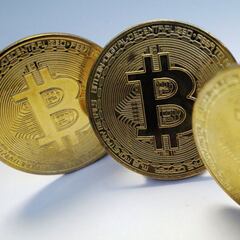What is Bitcoin? how does it make money and how is it produced or 'mined'?
Bitcoin led the way to the creation of digital currencies that can be traded over the internet free of control by a central bank or government.

Bitcoin came into existence in 2009 after the concept of a decentralized digital currency was presented by its mysterious creator Satoshi Nakamoto. Since then, it has become the standard for a raft of other cryptocurrencies that use peer-to-peer networks to keep a ledger of all transactions.
This decentralized system of using cryptography and numerous servers for recording and storing the account book of all transactions provides the means by which miners get paid and underpins the security of currency.
Also see:
- How are NFTs created? Why is bad their impact on environment?
- How does the infrastructure bill affect cryptocurrencies like Bitcoin?
- What does NFT mean? What is it and what's an example of it?
- Tom Brady admits he wants to be paid in Bitcoin
- Will Amazon accept Bitcoin as a payment method?
How does Bitcoin work?
In 2008 an academic white paper titled Bitcoin: A Peer-to-Peer Electronic Cash System by Satoshi Nakamoto, an invented name, laid out the system that would become the cryptocurrency Bitcoin. The digital coin is built on a decentralized peer-to-peer network that uses open-source software, so anyone can participate in maintaining the public ledger of all transactions.
Transactions are broadcast to the network and shared amongst all the servers, or nodes, which then reach a consensus on the transactions and include them in “blocks”. These are placed into the “blockchain” which stacks the information so that there is a permanent record of all transactions, decreasing the risk of a reverse transaction.
Elon Musk says dogecoin is better to buy things with than bitcoin (via @CNBCMakeIt) https://t.co/PDBnEV11aN
— CNBC (@CNBC) December 13, 2021
What is Bitcoin mining?
The peer-to-peer software that allows people around the globe to send Bitcoin money to each other also lets people provide their servers to process the transactions. The people who perform this service are known as "miners" and their computers synchronize the record of transactions establishing a consensus and thus secure the network.
For collecting the information and placing it on the blockchain miners receive a transaction fee. But they can also get Bitcoin for adding a new block onto the blockchain. This is done by completing a cryptographic calculation. The first miner to broadcast the next block is rewarded with a Bitcoin. However, over time it gets harder to mine new coins which are limited to 21 million in total.
What is the value of Bitcoin?
The value of this digital money is based on mathematics, instead of a physical property or government fiat. “As with all currency, Bitcoin's value comes only and directly from people willing to accept them as payment.”
90% of all the #bitcoin has now been mined, 90% of the remaining BTC to be mined will be mined by 2032.
— Lark Davis (@TheCryptoLark) December 13, 2021
Demand growing every day.
Number will go up
Just as with regular currencies or precious metals the value of Bitcoins fluctuate, but they are not legal tender in any country. However, individuals and businesses are using the cryptocurrency for transactions worth millions of dollars everyday.
Related stories
The value of a Bitcoin has seen spikes in the past only to decrease again. In the autumn of 2020 the value skyrocketed only to lose nearly half its gains the following spring. However, just a matter of months later, the cryptocurrency began climbing again, to almost double going over $68,000 briefly in November 2021.
The maximum number of Bitcoins is limited to 21 million, but each coin can be split into subunits. Currently there are 1,000,000 bits in one bitcoin, or divided up into 8 decimal places (0.000 000 01). If required in the future, more bits could potentially be created for ever smaller transactions. At the end of November 2021, there were just over 2.1 million Bitcoins left to be mined according to the Bitcoin supply chart.


